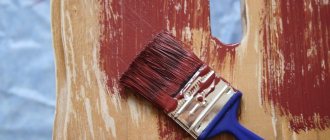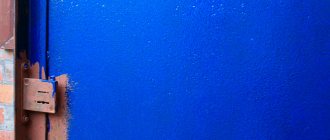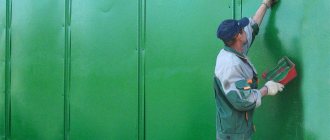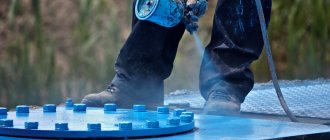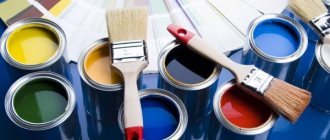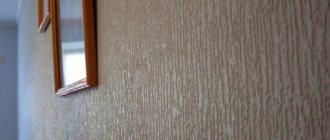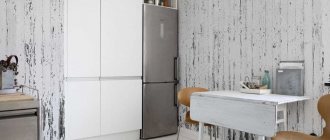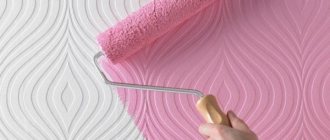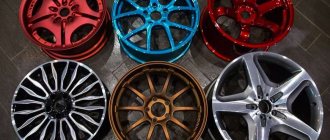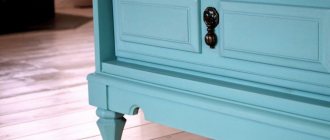Almost no construction project is complete without the use of galvanized iron - this material is strong, durable, resistant to temperature changes, and also relatively inexpensive. Galvanization is most often used for roofing or fencing elements, but often zinc-treated tin is used for various protection of structures (gutters, cornices, platbands, etc.). The main advantage of zinc coating is its increased resistance to corrosion compared to conventional iron. Painting further enhances this property.
Metal coated with zinc coating acquires anti-corrosion properties, becomes more resistant to environmental influences and, most importantly, lasts a long time. But there is one important nuance that increases the functionality of the material and guarantees the long-term durability of its performance properties: galvanization can be painted. How to do this correctly, what paint is suitable for galvanized coating - more on this below
Soil selection
Galvanization is a building material made of metal with a thin layer of zinc coating applied to it. Such metal requires preliminary protection from various atmospheric phenomena (industrial gases, precipitation, ingress of water-soluble salts, which can cause corrosion). Galvanized steel without a protective coating is “eaten away” by rust over time - the process manifests itself in the form of white spots. The surface of metal sheets takes on a faded appearance, dirty, blurry light spots are formed and, naturally, the top layer of the coating is damaged.
Practice shows that galvanization is not painted immediately, but after a year. But if it is necessary to paint galvanized elements immediately after installation, the surfaces are roughened using sanding paper with varying degrees of grain size or metal brush attachments. The procedure will improve the adhesion of paint to galvanized metal.
But before the main process, we will select a suitable composition for painting so that the galvanized product will serve for many years without changing in appearance or losing functionality. And the right tool - then the event will not become tiresome.
Antique painting
One of the most popular ways to paint black metal is the antique effect. In this case, several coating options are applied to the metal surface in a certain order. But first, the metal itself must be properly prepared. It must be cleaned of corrosion, sanded, and dirt and grease are removed. Only when you are confident that the surface is clean can you begin the process, which is divided into several stages:
- Using a brush, apply metallic paint to the surface. Don't be afraid to do it casually, as this will only help with the effect we are creating;
- Once the first layer has completely dried, it is necessary to apply a craquelure primer. The latter allows you to obtain a layer of transparent film created from polymers;
- The craquelure coating is applied after the primer layer has dried, which allows you to get characteristic cracks, similar to those that appear on things that have been used for decades and even centuries.
Important! Instead of a craquelure composition, the effect of antiquity can be achieved by applying burnt umber to the paint. In this case, it is best to work with a dry cloth, and remove the residue after the paint layer has dried.
What paint is suitable for galvanized steel
Rich, individual, bright colors turn galvanized gray iron into an original and durable building material with a high degree of protection from external environmental factors.
Other features of paints for galvanized surfaces:
- Resistant to fading.
- Aesthetic appearance.
- Safety of paint and varnish material for human health and the environment.
- High adhesion (reliable adhesion of surfaces with different textures) and elasticity.
- Hydrophobicity (water-repellent function).
These are the main criteria by which a solution for painting galvanized metal products is selected. This is what provides guaranteed additional protection for the structure of the upper layers of galvanized steel.
Also, the material for application to a metal surface must be technologically advanced: easy to apply by any means (brush, roller, spray), have maximum spreadability, dry quickly, not form streaks, and give a uniform, homogeneous layer.
- Universal, most affordable, with a long service life - powder paint. It is resistant to ultraviolet radiation, reacts impeccably to mechanical stress and precipitation, is applied in an even layer, and has a variety of shades. Factory galvanized products, as a rule, have a powder coating. A mixture based on polymers and epoxy resin is optimal in composition and price.
- Most often, at home, galvanization is also coated with acrylic paint - it guarantees the durability and strength of the steel. Zinc (aluminum) powder is used as pigmentation in the solution.
- For large areas and extensive surfaces, experts often recommend choosing acrylic mixtures based on ethyl alcohol, applied in one layer using a spray gun.
- Vinyl enamels are highly hygroscopic, frost-resistant and dry quickly.
- The urethane polymer coating is effective, bright, and durable; the solution has a high degree of adhesion to surfaces and decent abrasive resistance. The disadvantage of this solution for painting galvanized steel is its pungent odor.
Advantages of wood-look powder coating
Decorating a metal profile offers the consumer a number of advantages over painting it in a single color using the traditional method. The mechanical strength of powder coating is higher, and the coloring itself, imitating wood, marble or stone, is practically no different from natural materials. The resulting surface structure allows you to hide defects in the base, if any, and the product itself is lightweight, which is especially convenient if you are not painting it like wood, but stylizing it like stone. A profile decorated in this way can be used in a wide variety of areas where it is necessary to combine strength and durability with aesthetics.
How to paint galvanized steel without the paint peeling off
Multilayer coating - primer + enamel allows you to create a reliable adhesive layer with decorative functions.
Experts say that all prepared galvanized surfaces retain adhesive properties during the first 2-3 hours after processing the top galvanized layer.
To ensure that the paint on zinc products does not peel off or crack in the near future, and that it maintains its brightness, color and texture (without stains), there are three basic rules for painting:
- Primer or enamel is used exclusively on degreased surfaces.
- The maximum effect is achieved if the top layer of metal with a zinc composition is treated with primer-enamel.
- The paint should be applied in 2-3 successive layers.
Working with a spray gun simplifies and facilitates the entire process and allows for uniform application.
Surface preparation
What needs to be done next to prepare the product for painting:
- Degreasing the surface with white spirit, acetone or kerosene will clean the top layer of galvanized iron from plaque, rust, dust and other small particles.
- The next step is to select a specialized primer for galvanized metal. High-quality and maximally compatible (ideally the same brand and the same manufacturer as the subsequent paint) latex or epoxy-based primer - it is more resistant to mechanical stress.
- Using the same algorithm, you can use an analogue - primer-enamel, a two-component topcoat, chosen directly for preparing galvanized surfaces for painting.
- The final stage is painting. This procedure begins 5-7 hours after applying the protective primer.
Painting correctly: methods of applying enamel for galvanizing
The entire set of painting processes is given in step-by-step instructions.
- Primer and enamel, as a rule, are allowed to be used in a temperature range from +5 to +30 degrees, humidity 70%. Painting begins in dry, windless weather.
- Coating thickness is from 80 to 100 microns. Layers are achieved by applying two layers.
- If a two-component solution is used: enamel combined with a primer, then the mixture, if necessary, is brought to working condition by diluting with a solvent or toluene.
- After combining the components, it is necessary to soak the solution for about 30 minutes for better mixing of the components.
- Next, paint is applied using a roller or brush (in hard-to-reach areas), or a spray gun.
- If you work with a sprayer, to achieve uniformity of layers, the paint is first filtered through gauze or technical nylon.
- Subsequent layers are applied after the previous ones have completely dried.
Advice for those who are planning to paint a metal surface at sub-zero temperatures
Although this advice may apply more to ordinary painting than decorative painting, situations are different. For example, you need to immediately paint a part that has just been brought in from the cold. Therefore, we will give some tips:
- The best way to paint in cold weather is to use alkyd enamels with a jelly-like consistency that have high adhesion (the ability to penetrate the surface structure);
- Painting a surface cooled to temperatures below +5 degrees Celsius should be done exclusively with preliminary treatment of this very surface with a torch or heat gun. Otherwise, condensation will form on the surface on which the paint simply will not adhere;
- If the room itself is cold when painting, the drying time of the layer can increase several times, which is especially unpleasant for decorative painting. Therefore, it is recommended to install a heat gun and cover the surface with film.
The essence and features of the method
Painting of metal products was initially used to change color and give surfaces an interesting shade, but simple enamel quickly cracked and rust appeared underneath. Therefore, manufacturers began to develop new types of coloring compounds that could protect the metal from corrosion.
On sale you can find different types of paint that is suitable for metal surfaces. It can be applied in different ways. In this case, hand tools and industrial equipment are used.
Painting plastic to look like wood
There is nothing difficult in carrying out this task. But in order not to spoil the material and make the coating durable, you need to know some quality characteristics of the materials:
- There are types of plastic that cannot be painted;
- after sanding, the plastic is coated with a primer;
- Some types of paints that serve as a solvent for plastic cannot be used for painting.
To achieve a perfect resemblance to wood, you should not use a roller during the painting process. It is best to use a wide, medium-hard brush.
As a result of this painting, the white color of the doors becomes the color of wood. In the interior of the room, a wooden door looks much richer and more prestigious. While maintaining the quality of plastic, the external design of the doors takes on the appearance of a wooden product.
A thin film is applied to the plastic, which imitates the pattern of wood materials. This gives the door a qualitatively new design solution, while the structure of the material remains the same. When the paint dries, it forms a durable protective layer, similar in appearance to natural wood. A good result is obtained after painting with acrylic paints and varnishes.
On video: how to paint various materials to look like wood.
Application methods
To apply paint you can use:
- Paint brush. Suitable for painting small parts. You can find brushes of different sizes on sale. The bristles can be natural or synthetic. For access to hard-to-reach places, the tool is equipped with an elongated curved handle.
- Roller. Suitable for painting large flat surfaces.
- Sprayers. The second name for the spray gun. A compressor is used to operate them. The coloring composition is supplied under pressure. The equipment is used by large enterprises, car repair shops, carpentry, and blacksmith shops.
- Containers for dipping metal workpieces. This method makes it easy to paint parts with complex shapes.
Modern technology - powder coating of metal. The blanks are placed in a closed spray booth and covered with a layer of paint. Its particles receive a negative electrical charge and are attracted to the working surface, creating a dense, uniform layer. After applying the powder, the workpiece is placed in an oven so that the decorative layer bakes and becomes monolithic.
Paint brush
